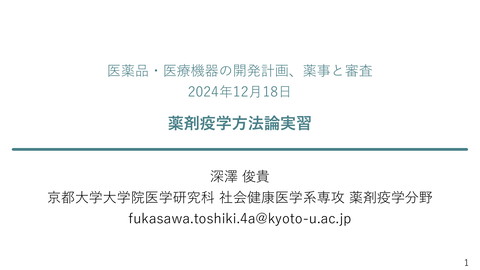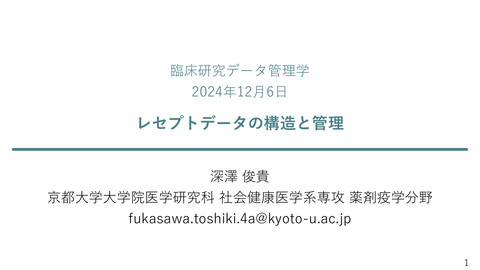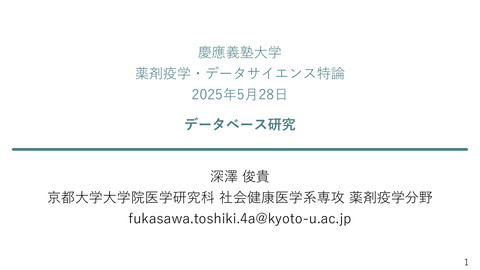Early-Career Pharmacoepidemiologists: Perspectives and Progress from Asia
1.6K Views
October 14, 24
スライド概要
The 16th Asian Conference on Pharmacoepidemiology
October 12–14, 2024, Tokyo, Japan
https://www.asianpharmacoepi.org/
京都大学大学院医学研究科社会健康医学系専攻薬剤疫学分野 講師
関連スライド
各ページのテキスト
Early-Career Pharmacoepidemiologists: Perspectives and Progress from Asia — Japan ACPE 2024 | October 14, 2024 Toshiki Fukasawa, PhD Assistant Professor Department of Pharmacoepidemiology 1
Disclosures Toshiki Fukasawa has been employed by the Department of Digital Health and Epidemiology, an Industry-Academia Collaboration Course supported by Eisai Co., Ltd. and Kyowa Kirin Co., Ltd., and has received consulting fees from Real World Data Co., Ltd. and JMDC Inc. 2
Overview 1 My Career Journey as a Pharmacoepidemiologist 2 Japan’s Health Insurance System 3 Electronic Health Databases and Study Examples 3
Overview 1 My Career Journey as a Pharmacoepidemiologist 2 Japan’s Health Insurance System 3 Electronic Health Databases and Study Examples 4
Education Background and Professional Experience Education • BS (Pharmaceutical Sciences), Keio University, Japan, 2017 • MS (Pharmaceutical Sciences), Keio University, Japan, 2019 • PhD (Medical Science), Kyoto University, Japan, 2024 Experience • Research Associate, Tohoku University, Japan, 2019 - 2020 • Assistant Professor, Kyoto University, Japan, 2020 - Present • Senior Consultant (Contract), Real World Data Co., Ltd., Japan, 2020 - 2024 • Advisor (Contract), JMDC Inc., Japan, 2024 - Present 5
Experience at Kyoto University School of Public Health • As of 2024, we have 8 faculty members and 45 graduate students in our lab. • As an Assistant Professor, I have supervised 10 graduate students. 6
Experience at Real World Data Co., Ltd. and JMDC Inc. As an Advisor, I have guided pharmacoepidemiological studies for pharmaceutical companies. 7
Overview 1 My Career Journey as a Pharmacoepidemiologist 2 Japan’s Health Insurance System 3 Electronic Health Databases and Study Examples 8
Japan’s Health Insurance System Established in 1961 with Three Key Features 1. Universal Health Care: Guarantees coverage for all citizens. 2. Free Access to Healthcare Providers: Guarantees access to any health provider without referrals. 3. Affordable Care through Variable Copayments: Adjusts copayments based on age and financial status, ensuring healthcare is accessible to all. 9
Feature 1: Universal Health Care Health Insurance System Insured Persons (N) (1) Employee’s health insurance Employees and their family members (77.4 million) (2) National health insurance Unemployed, self-employed, or retired individuals and their family members (28.1 million) (3) Late-stage medical care system for the elderly People aged 75 and older (18.4 million) Age 0–74 years ≥75 years 10
Feature 2: Free Access to Healthcare Providers Japan e.g., UK, the Netherlands, Canada Clinic General Practitioner Secondary Hospital Tertiary Hospital Hospitals 11
Total Fee Feature 3: Affordable Care through Variable Copayments Copayment 20% 0–5 years 30% 6–69 years 20% 10% 70–74 years ≥75 years 12
Insurance Treatments and Real-World Data Generation Insured Person Insurer Medical Institutions Claim Hospital-Based Databases Claim Examination and Payment Organization Administrative Claims Databases 13
Overview 1 My Career Journey as a Pharmacoepidemiologist 2 Japan’s Health Insurance System 3 Electronic Health Databases and Study Examples 14
Electronic Health Databases in the World Claims data only Claims and laboratory data Administrative Claims Databases Hospital-Based Databases Primary Care-Based Databases Integrated Healthcare Databases Primary care Primary care Primary care Primary care Specialist Inpatient Specialist Inpatient Specialist Inpatient Specialist Inpatient care care care care care care care care
(1) Administrative Claims Databases in Japan Database Primary care Specialist Inpatient care care • National Database (NDB): Covers almost all Japanese citizens. • JMDC Claims Database*: Covers employees and their family members under 75 years old. • DeSC Database*: Includes diverse populations across various ages and social backgrounds. *Commercially available. Information • Demographics • Inpatient and outpatient diagnoses • Procedures • Drug dispensing • Health checkups: Primarily for ages 40–74 years16
Study Example Using an Administrative Claims Database Sulfa drugs and glycopeptides carry a high risk of SJS/TEN, while the risk is lower for other antibiotics. Fukasawa T et al. J Allergy Clin Immunol Pract. 2023;11(11):3463-3472. 17
Unique Aspects of This Study 1. Using an algorithm developed by our team in a previous study (sensitivity 77%, specificity 99%). 2. Employing a case-crossover design to control for genetic factors. 3. Conducting cohort studies to estimate the cumulative incidence of SJS/TEN for each antibiotic class. Fukasawa T et al. PLoS One. 2019;14(8):e0221130. Clinical course of SJS/TEN Mucocutaneous lesions from SJS/TEN Exclusion of autoimmune bullous diseases 18
(2) Hospital-Based Databases in Japan Database Primary care MID-NET, RWD Database*, JMDC Hospital Database*, MDV Database*: Cover both inpatient and outpatient services in treated hospitals. *Commercially available. Information • Demographics Specialist Inpatient care care • Inpatient and outpatient diagnoses • Procedures • Drug dispensing • Discharge summaries • Laboratory values: Fully available from MID-NET and RWD Database; partially available from JMDC Hospital Database and MDV Database 19
Study Example Using a Hospital-Based Database In real-world clinical practice, edoxaban, rivaroxaban, and apixaban demonstrate comparable effectiveness and safety in the treatment of VTE. Fukasawa T et al. J Thromb Haemost. 2022;20(9):2083-2097. 20
Unique Aspects of This Study 1. Using matching weights to simultaneously compare 3 treatment groups: edoxaban, rivaroxaban, and apixaban. 2. Using laboratory data in patient subsets to evaluate the balance among treatment groups. 3. Adjusting for body weight, as only edoxaban has dose reduction criteria based on weight. 21
Future Perspectives 1. Expand international research collaborations globally, particularly in Asia, to improve public health outcomes across the region (e.g., my ongoing collaboration with Dr. Nhung Trinh, University of Oslo). 2. Continue training and mentoring graduate students to help cultivate the next generation of pharmacoepidemiologists. 3. Further promote the field of pharmacoepidemiology in Japan. 22





